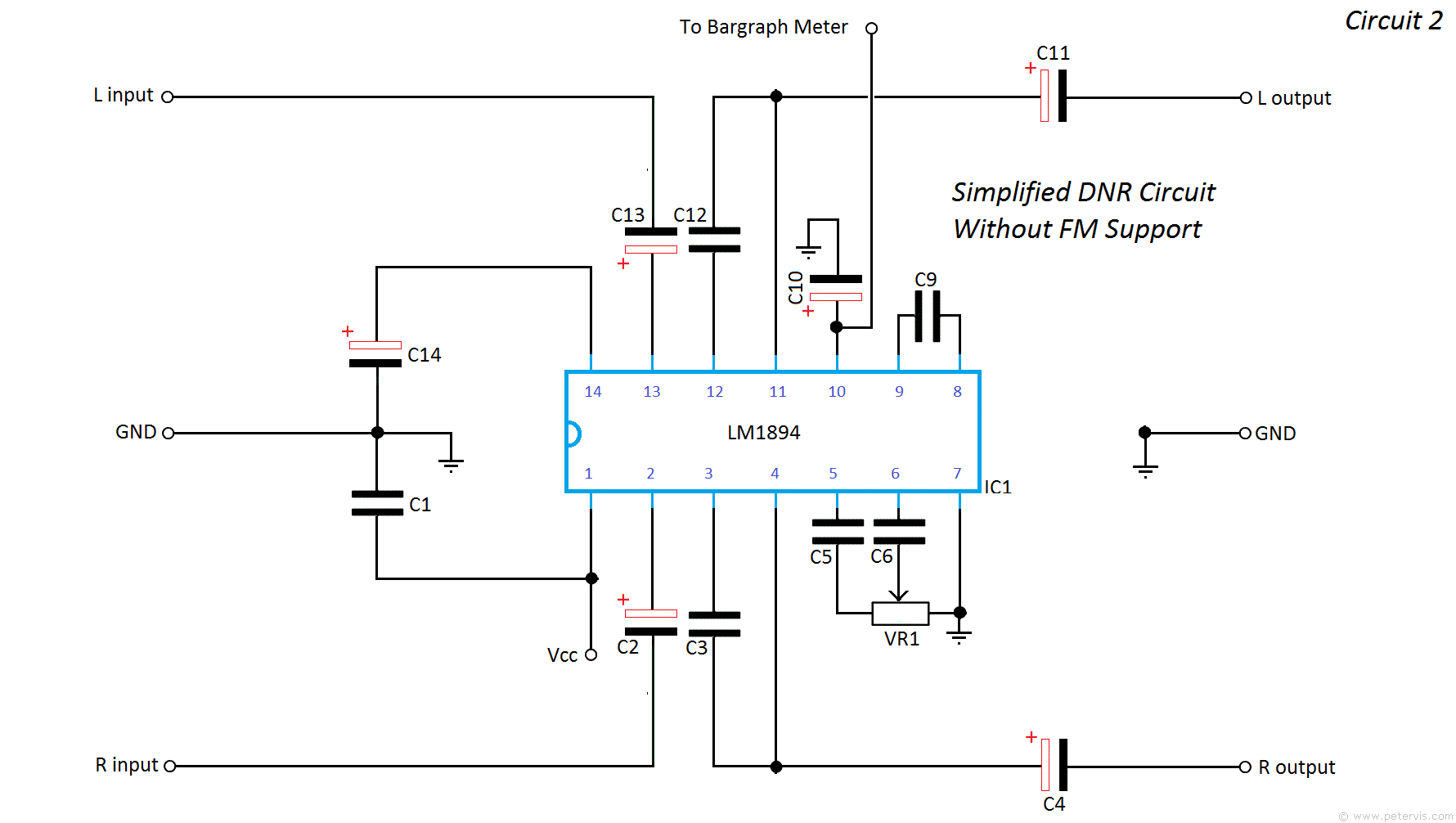Dynamic Noise Reduction Circuit (DNR)
Dynamic Noise Reduction (DNR) is a method of removing noise from an audio signal, because any media that stores signals in analogue format is usually prone to such noise issues. An audio magnetic tape that stores data on grains of magnetic particles may exhibit noise after a few years. This noise may be due to the tape wearing out or perhaps damage due to heat, which may demagnetise the particles. Noise also occurs on records when the groove wears out. An ideal filter is one which will remove the noise component and leave the rest of the signal unaffected, however many filters are far from being ideal. There are also software based filters such as Audacity, which will filter noise, however this involves digitising the signal first. This circuit maintains the signal in analogue form and uses psychoacoustic masking and adaptive bandwidth techniques to achieve 10 dB noise reduction. The circuit works well with tape decks and cassette players, and I also experimented using it with records.
LM1894 DNR System
This circuit works very well because it uses psychoacoustic techniques to reduce the noise level. These are some very clever and advanced tricks with much science behind making them far better than ordinary filters. Psychoacoustic techniques are also used widely in MP3 compression, where parts of the sound spectrum that are outside of the human hearing are removed, thereby reducing the size of the data footprint.
This IC also uses white noise to mask sound, which is an interesting method not commonly found in simple filter circuits. In addition, since the human hearing cannot detect sound lasting less than a millisecond, this IC uses compression techniques to minimize the noise level. Finally, it also reduces the bandwidth of the signal to the precise audible range; hence, eliminating any noise falling outside the range. All of these techniques together provide a generous 10 dB noise reduction, whilst leaving the original signal relatively unscathed. This circuit is very different from active and passive filters commonly used in noise reduction, and those types of filters, including graphic equalisers, generally do not perform as well and end up changing the characteristics of the original signal. Although this circuit has wide applications, it is very popular with people who still listen to tape, and reel-to-reel, and especially where high audio quality is important. It is also ideal if you are a reel-to-reel user and you want to listen to your archive with an on-the-fly filtering system.
An advantage of this circuit is that it is an IC solution with minimal component count. The IC will operate on a wide range of voltages from 4.5 V to 18 V, and I tested my build with a 9 V power supply. This circuit has a 1 V rms input overload, and I simply connected it between the line-in of the amplifier and line-out of the tape deck, and it worked!
Simplified Circuit Without FM Support

Circuit 1 has a 19 kHz FM pilot filter to help reduce FM noise and in particular the hiss, and this is achieved with components C9, L8, R8, CL, and C8. If you are not going to use this DNR circuit with FM radio, then these components can be omitted and you simply require C9 (0.047 µF) between pin 8 and pin 9. As you can see in circuit 2 above, this greatly reduces the component count.
Component List
| VR1 | 1 kΩ |
| R8 | 100 Ω |
| C1 | 0.1 µF |
| C2 | 1 µF |
| C3 | 0.0033 µF |
| C4 | 1 µF |
| C5 | 0.1 µF |
| C6 | 0.001 µF |
| C8 | 0.1 µF |
| C9 | 0.047 µF |
| C10 | 1 µF |
| C11 | 1 µF |
| C12 | 0.0033 µF |
| C13 | 1 µF |
| C14 | 100 µF |
| CL | 0.015 µF |
| L8 | 4.7 mH (TOKO CAN-1A185HM) |
| IC1 | LM1894 |
Bargraph Meter

This DNR is a low pass filter with a variable bandwidth from 1 kHz to 30 kHz. A variable bandwidth is useful as it allows one to "tune" out the noise precisely depending upon the recording media. By adjusting the potentiometer VR1, we can change the sensitivity thereby setting the noise threshold. For example, if you have a tape with a constant noise at a particular frequency, then adjusting VR1 such that pin 10 just begins to register a voltage will tune out that noise. To provide a type of tuning support, a bar graph meter circuit as shown above can help. This type of tuning works best with tape where the lead-in exhibits the noise component, which could be used as a reference noise for tuning purposes.
